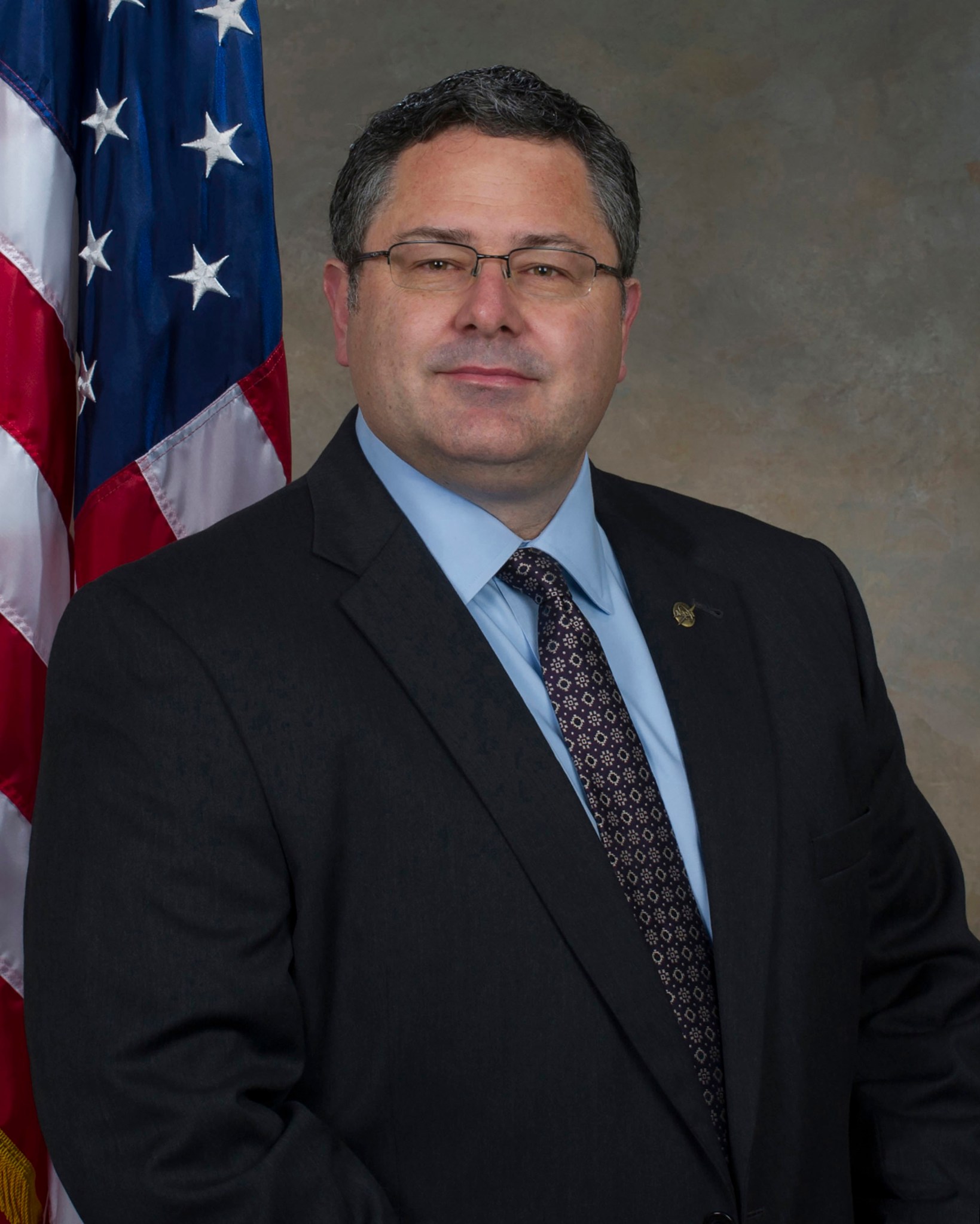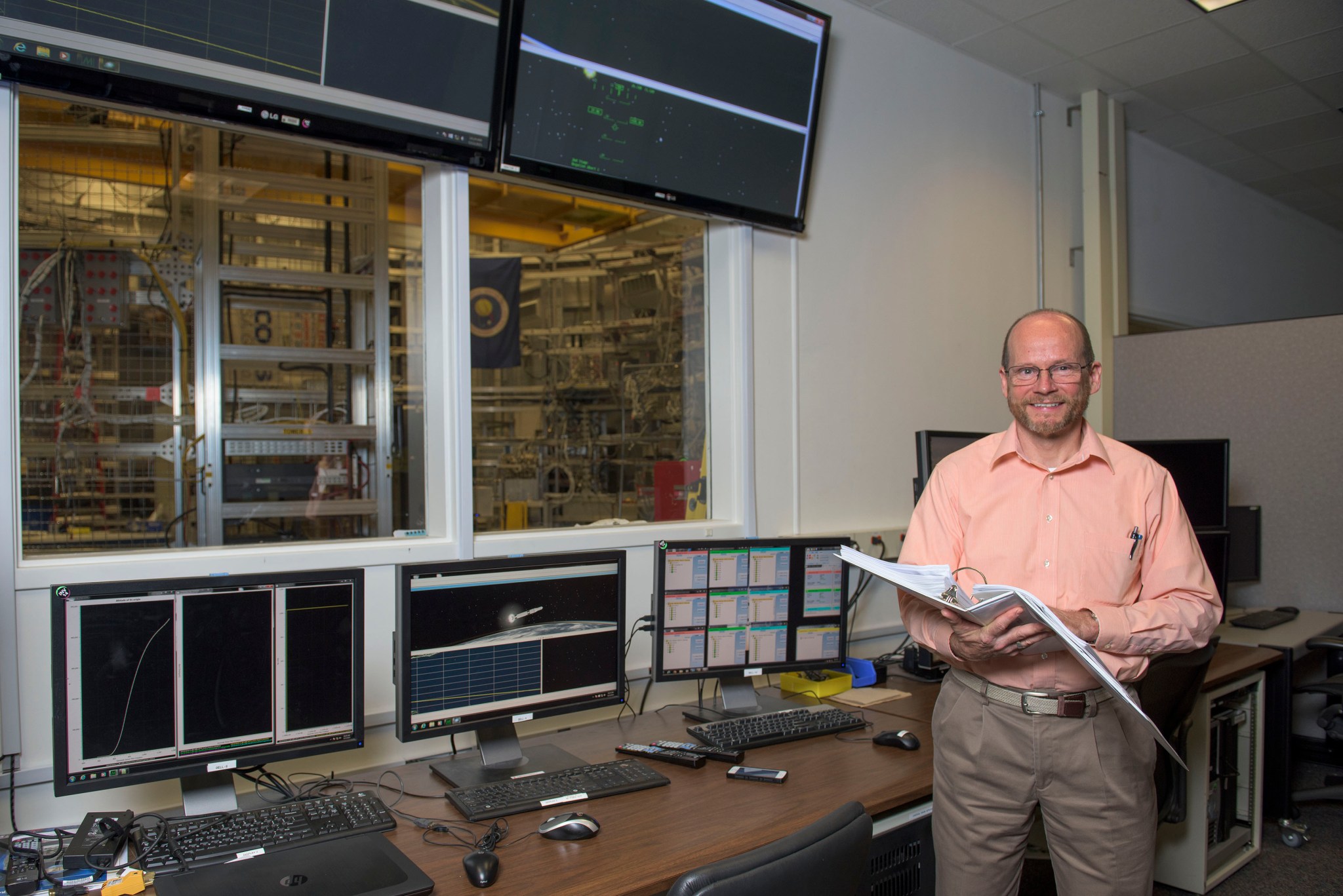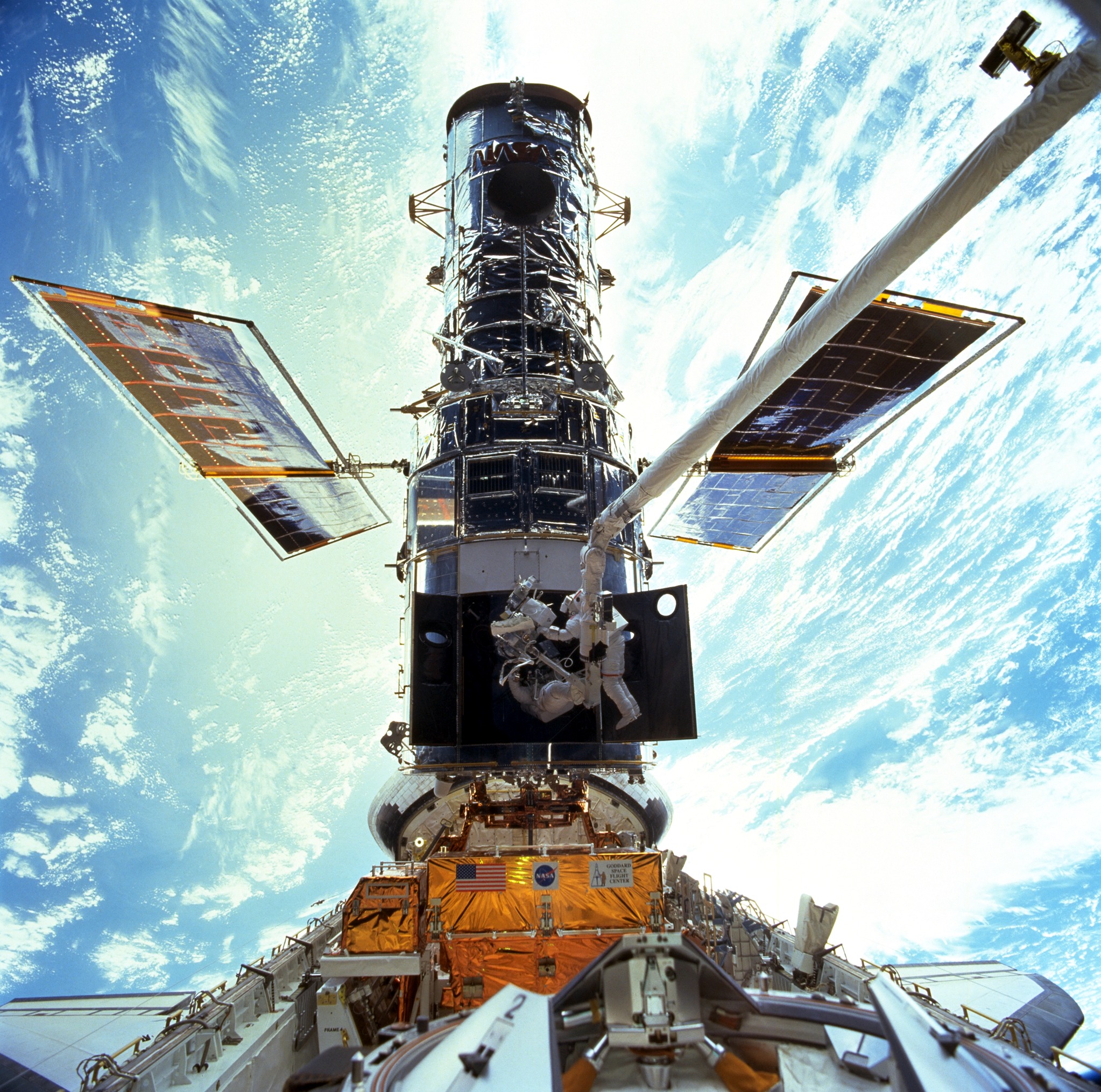In This Week’s Star
- Director’s Corner: Season’s Greetings at the Best Place to Work
- New Test Stand Highlights NASA Administrator Bolden’s Marshall Visit
- Marshall’s John Hanson Wins AIAA Award for Work on SLS Rocket
- NASA’s New Flight Directors Tour Marshall
- Geminid Shower Doesn’t Disappoint as Fans and NASA Experts Chat Online
- Mission Success Is in My Hands: Q&A with Steve Wofford
- Be an Astronaut: NASA Seeks Explorers for Future Space Missions
- Marshall Team Puts The ‘Fun’ In Fundraising With ‘No-Shave November’
- This Week in NASA History: Discovery Launches on Hubble Servicing Mission — Dec. 19, 1999
- Obituaries
Director’s Corner: Season’s Greetings at the Best Place to Work
Marshall Team,
With the holidays upon us, I wish you a season of joy and renewal. Also, congratulations on a remarkable year of progress on our path of human space exploration and journey to Mars.
This year we have added cause to celebrate. NASA Administrator Charles Bolden recently announced that NASA is the best place to work in government in the large agency category for the fourth year in a row. On top of that, NASA’s Marshall Space Flight Center ranks number seven out of 320 sub-agencies. You are a remarkable team at all levels. You can find the full results of the 2015 “The Best Places to Work in the Federal Government” rankings by clicking here.
Being the best place to work isn’t just about numbers. In our case, it’s about Marshall creating an even better work environment than the year before. It’s about managers at all levels listening and leading and employees in teams focusing on results. It means mission success and milestones accomplished by a dynamic, dedicated workforce from Huntsville to Michoud and beyond. Thank you for your commitment and passion to America’s space program.
The holiday season is a busy time for all of us, a time when we have so much to do that it’s hard to know where to focus our attention. As you enjoy the season, I ask that you take a few moments from the hustle and bustle to focus on safety. I hope that over the holiday you will take special care and will plan for your safety at work, on the roads and at home so you can return to work with great holiday memories.
Finally, let us also continue to be mindful of those around us who are less fortunate, reaching out and supporting those for whom this period may be especially difficult.
Thank you again for a 2015 to remember. May this special season be filled with wonder, and may you enjoy all the best in the New Year.
Happy holidays!
Todd
New Test Stand Highlights NASA Administrator Bolden’s Marshall Visit
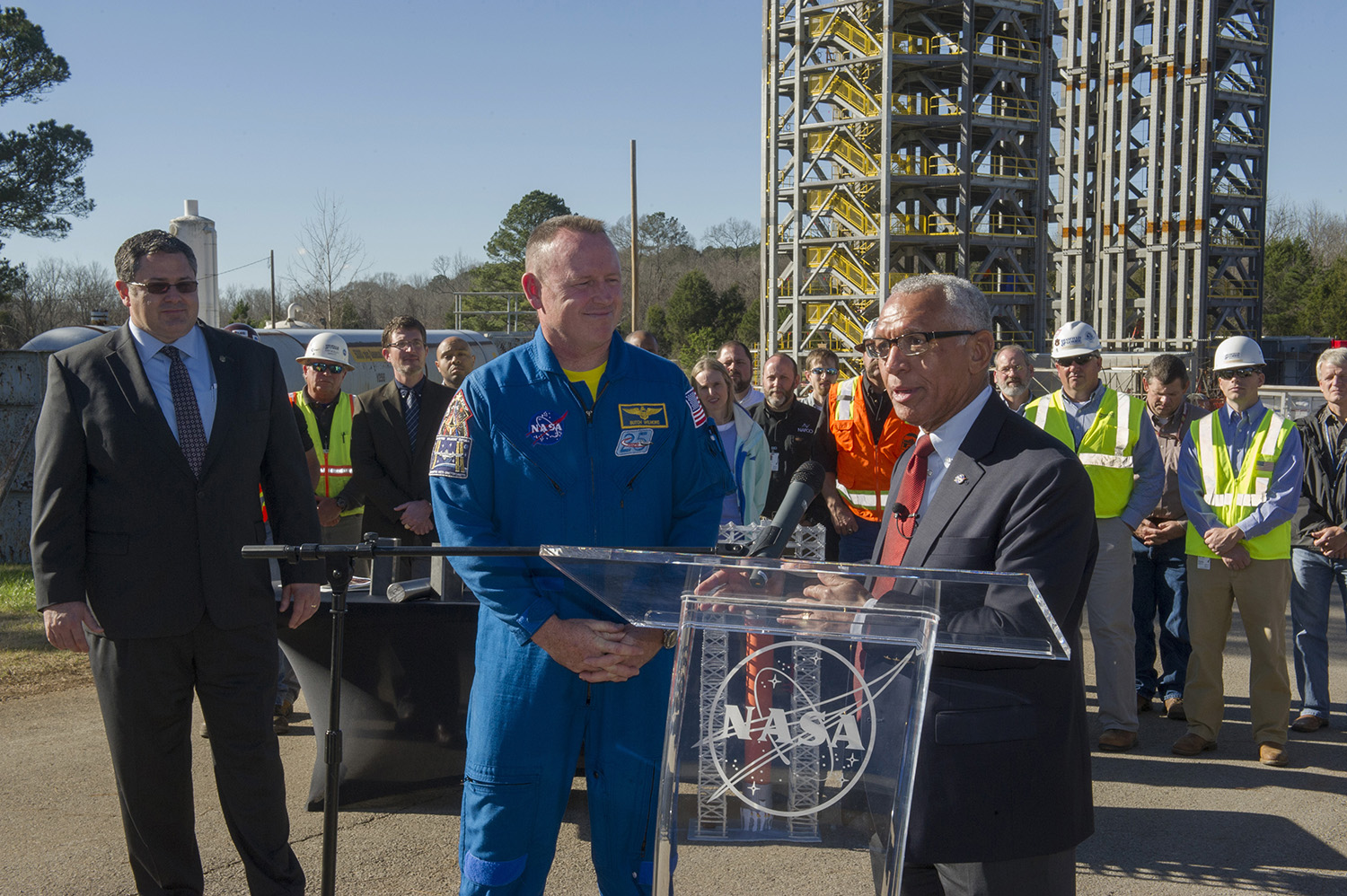
NASA Administrator Charles Bolden, right, visits the newest addition to Huntsville’s skyline — Marshall’s Test Stand 4693 – on Dec. 14 with astronaut Butch Wilmore, center, Acting Marshall Center Director Todd May, left, Space Launch System leaders and industry partners. The two-tower steel structure will stand 215 feet tall when completed in late 2016, and will facilitate rigorous testing of the core stage of SLS against the stresses of launch. Following his remarks and a media opportunity, Bolden also visited the SLS Launch Vehicle Stage Adapter, as well as a solar sail in development to support two SLS CubeSat secondary payload projects. (NASA/MSFC/Emmett Given)
Marshall’s John Hanson Wins AIAA Award for Work on SLS Rocket
By Megan Davidson
John Hanson is keeping his eyes on the prize of helping build the most powerful rocket in history, NASA’s Space Launch System, for the journey to Mars and other destinations in deep space. And for those efforts, he’s getting a prestigious prize of his own from the world’s largest aerospace professional society.
Hanson, alternate lead systems engineer in the Spacecraft and Vehicle Systems Department of the Engineering Directorate at NASA’s Marshall Space Flight Center, has been honored by the American Institute of Aeronautics and Astronautics with the 2016 de Florez Award for Flight Simulation.
The award is for Hanson’s outstanding innovations and contributions in flight simulation applications for SLS design, development and requirements verification. “It is such an honor to win this award,” Hanson said. “And I’m excited about helping make SLS a success.”
AIAA will present Hanson with his award during a Jan. 5 ceremony in San Diego. “John is considered the ‘go-to guy’ for how to apply flight simulation for launch vehicle success,” said John Hutt, SLS lead systems engineer who nominated Hanson for the award. “He earned this respect through many years of innovative, thoughtful application of his expansive talent.”
Hanson’s NASA career spans more than 25 years. In his current role at Marshall, where the SLS Program is managed for the agency, he is responsible for the development of SLS vehicle system requirements and verification. He also has led the implementation of SLS model-based design development, which is used to create simulations that aid in determining things like the rocket’s guidance, navigation and control systems.
Hanson also was an integral part of the successful completion of the SLS critical design review – a first in almost 40 years for a NASA human-rated rocket.
“SLS is a complex machine that has a lot of parts that need to work together,” Hanson said. “So in my job, I have to know something about just about everything that is going on with SLS, and try to solve issues when they come up — issues that involve more than just one group of people who can solve them. I spend a lot of time talking to people and working with them to figure things out.”
“For my whole career at NASA, I’ve wanted to contribute to making something fly successfully in space — something that is important to the nation,” Hanson added. “SLS is my opportunity to do that, and I want to make the best of it.”
Originally from Columbia, Maryland, Hanson holds a bachelor’s degree in physics from Loyola University in Baltimore, and a master’s degree and a doctorate in aerospace engineering from the University of Michigan in Ann Arbor.
During his NASA career, he has received several other awards for his work, including a NASA Exceptional Achievement Medal and a Silver Snoopy Award. The Silver Snoopy is one of the agency’s highest honors for outstanding achievements related to human flight safety or mission success. The award is presented by the NASA astronaut corps, as it represents the astronauts’ own recognition of excellence.
Per AIAA, the de Florez Award for Flight Simulation honors the memory of the late Admiral Luis de Florez, who was influential in the development of early flight simulators, and was a pioneer in the use of “virtual reality” to simulate flight and combat situations in World War II. The award recognizes an outstanding individual achievement in the application of flight simulation to aerospace training, research and development.
Davidson, an ASRC Federal/Analytical Services employee, supports the Office of Strategic Analysis & Communications.
NASA’s New Flight Directors Tour Marshall
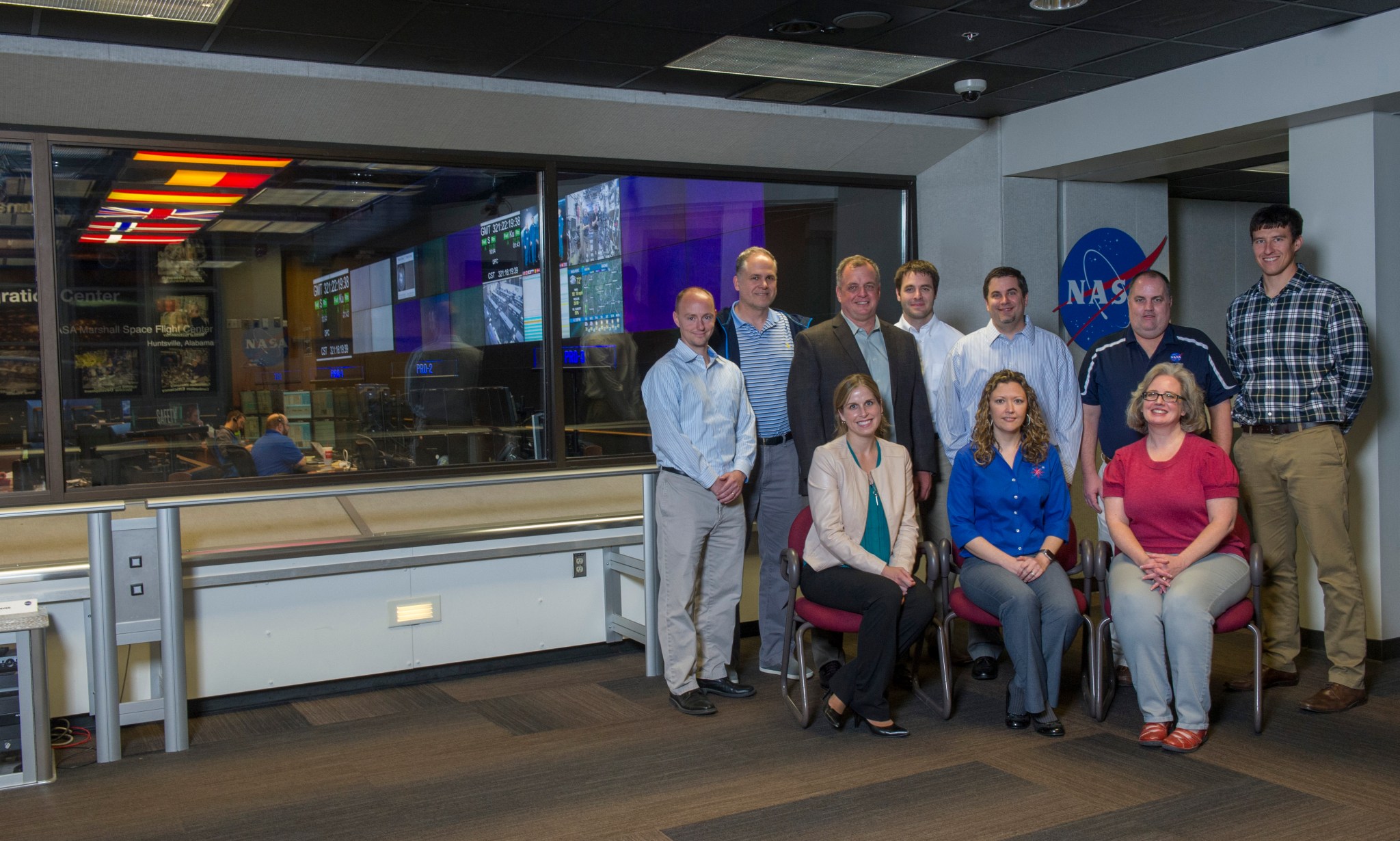
The newest class of flight directors from NASA’s Johnson Space Center recently toured the Marshall Space Flight Center including the International Space Station Payload Operations Integration Control Center in Building 4663. The new team is visiting several NASA centers before starting intensive training that culminates in official certification a year after selection. During a space station expedition, flight directors in NASA’s mission control in Houston direct operations including crew activities on the space station, but they also collaborate on a daily basis with payload operations directors at Marshall who manage the team of controllers who guide science activities on the space station. In the viewing room outside of the POIC are, seated from left, Flight Director Mary Lawrence; Payload Operations Directors Stephanie Dudley and Becky Grimaldi; and standing from left, FD Vincent Lacourt; POD Jimmy Whitaker; FD TJ Creamer — a veteran space station astronaut and former POD; FD Anthony Vareha; PODs Jason Norwood and Steven Dyer; and FD Rick Henfling. (NASA/MSFC/Emmett Given)
Geminid Shower Doesn’t Disappoint as Fans and NASA Experts Chat Online
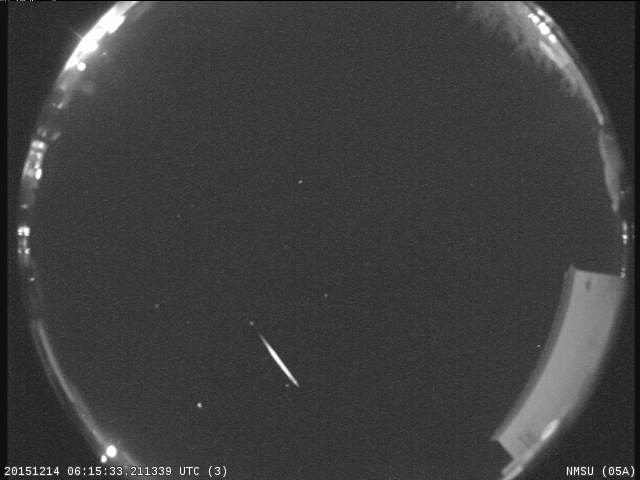
A Geminid meteor lights up the December desert sky, caught in motion Dec. 13 by one of NASA’s All Sky cameras near Tucson, New Mexico. The annual shower brought both the expert and casual viewers together for this nighttime light show as meteor experts from NASA’s Meteoroid Environment Office, located at NASA’s Marshall Space Flight Center, answered hundreds of questions, live, on Twitter Dec. 13. The Geminid meteor shower occurs due to pieces of debris from an object called 3200 Phaethon. In mid-December, as Earth orbits the sun, it passes through a stream of debris from 3200 Phaethon. This debris stream causes meteors to appear to come from the constellation Gemini. Long thought to be an asteroid, Phaethon is now classified as an extinct comet. The shower lasts a couple of weeks, with meteors typically seen Dec. 4-17, peaking near Dec. 13-14.(NASA/MSFC/Bill Cooke)
Mission Success Is in My Hands: Q&A with Steve Wofford
Steve Wofford, manager of the Space Launch System Liquid Engine Office at NASA’s Marshall Space Flight Center, recently talked with Marshall Public Affairs Officer Molly Porter about “Mission Success Is in Our Hands,” an initiative underway at Marshall to strengthen team members’ commitment to mission assurance and flight safety.
Years at Marshall: I have worked here 29 years. The first 13 years were as a support contractor, and the remaining 16 have been as a civil servant.
What are the key responsibilities of your current job?
Our office is responsible for all aspects of the liquid engines for the SLS Program including design, development, testing, fabrication and certification for flight of these engines. Our office priorities, in order, are fly safely, support the manifest, improve affordability and keep our schedule and integration commitments to other elements and programs.
How does your work support the safety and success of NASA and Marshall missions?
We work all day, every day on flying SLS safely, affordably and on schedule. This includes developing a new ablative insulation system on the RS-25 nozzles, investing heavily in additive manufacturing research, running tests at Stennis Space Center to develop and certify our new engine controller, inventing a new manufacturing process or sequence to make a certain part more affordably and many other activities. It’s why we come to work every day.
What does “Mission Success is in our Hands” mean to you?
Success is always about safety first, and I’ll be the first to lay in the flame trench if something isn’t safe to fly — but part of flying safely is flying. There is always risk to be managed in spaceflight, particularly human spaceflight. Risk has to be managed smartly and it’s the responsibility of every team member to think about it. We all also have to think about affordability, whether it comes from keeping our budgetary commitments, making parts in new ways or challenging the ways we do business.
Do you have a story or personal experience you can share that might help others understand the significance of mission assurance or flight safety? What did you learn from it?
Once I was at a flight readiness review at Kennedy Space Center for an upcoming shuttle launch. A presentation was being given about a technical issue in an area that was not part of my responsibility, but I was listening and observing the proceedings. I was struck by what seemed like inadequate flight rationale, but I assumed that the people involved and the people receiving the information knew more background on the issue that wasn’t included in the presentation. I kept telling myself, “Well, this is a really terrible presentation on flight rationale, but I’m certain that the analysis and the story is really there to support it, they’re just doing a bad job of presenting it.” Later discussion revealed that it was, in fact, inadequate flight rationale. The lesson here is don’t be a bystander and assume that somebody else who knows a lot more about the subject isn’t worried about the question in your mind. Be courageous and ask what you think is the obvious question.
How can we work together better to achieve mission success?
It’s all about communicating honestly and effectively. When you’re accountable, you have to engage and understand, not be a bystander. And we’re all accountable.
Be an Astronaut: NASA Seeks Explorers for Future Space Missions
In anticipation of returning human spaceflight launches to American soil, and in preparation for the agency’s journey to Mars, NASA is accepting applications for the next class of astronaut candidates.
The agency will accept applications through mid-February and expects to announce candidates selected in mid-2017. Applications for consideration as a NASA astronaut will be accepted at: http://www.usajobs.gov.
The next class of astronauts may fly on any of four different U.S. vessels during their careers: the International Space Station, two commercial crew spacecraft currently in development by U.S. companies, and NASA’s Orion deep-space exploration vehicle, to be launched on NASA’s Space Launch System.
“This next group of American space explorers will inspire the Mars generation to reach for new heights, and help us realize the goal of putting boot prints on the Red Planet,” said NASA Administrator Charles Bolden. “Those selected for this service will fly on U.S. made spacecraft from American soil, advance critical science and research aboard the International Space Station, and help push the boundaries of technology in the proving ground of deep space.”
The workforce at the NASA Marshall Space Flight Center’s Payload Operations Integration Center — the science command post for the space station — is looking forward to the “new blood” joining the astronaut corp.
“The diversity of backgrounds and personalities bring a new perspective when it comes to tackling challenges,” said Jason Norwood, an International Space Station payload operations director at Marshall. “Like the rest of us, they have that innate desire to explore and discover new things — from medical or scientific advances to exploration of Earth or other worlds. They can infuse new energy and enthusiasm to NASA’s mission.”
The space agency is guiding an unprecedented transition to commercial spacecraft for crew and cargo transport to the space station. Flights in Boeing’s CST-100 Starliner and SpaceX Crew Dragon will facilitate adding a seventh crew member to each station mission, effectively doubling the amount of time astronauts will be able to devote to research in space.
Future space station crew members will continue the vital work advanced during the last 15 years of continuous human habitation aboard the orbiting laboratory, expanding scientific knowledge and demonstrating new technologies. This work will include building on the regular six-month missions and this year’s one-year mission, currently underway aboard the station, which is striving for research breakthroughs not possible on Earth that will enable long-duration human and robotic exploration into deep space.
“This is an exciting time to be a part of America’s human space flight program,” said Brian Kelly, director of Flight Operations at NASA’s Johnson Space Center. “NASA has taken the next step in the evolution of our nation’s human spaceflight program — and our U.S. astronauts will be at the forefront of these new and challenging space flight missions. We encourage all qualified applicants to learn more about the opportunities for astronauts at NASA and apply to join our flight operations team.”
To date, NASA has selected more than 300 astronauts to fly on its increasingly challenging missions to explore space and benefit life on Earth. There are 47 astronauts in the active astronaut corps, and more will be needed to crew future missions to the space station and destinations in deep space.
Astronaut candidates must have earned a bachelor’s degree from an accredited institution in engineering, biological science, physical science or mathematics. An advanced degree is desirable. Candidates also must have at least three years of related, progressively responsible professional experience, or at least 1,000 hours of pilot-in-command time in jet aircraft. Astronaut candidates must pass the NASA long-duration spaceflight physical.
For more information about a career as a NASA astronaut and application requirements, click here.
Marshall Team Puts The ‘Fun’ In Fundraising With ‘No-Shave November’
By Jenalane Rowe
Which would you vote for: The Turtleneck, Zeus or Mutton Chops?
These beard designs were the candidates for the 2015 “No-Shave November” fundraiser held by the Space Systems Department at NASA’s Marshall Space Flight Center. Participating team members agreed to shave their beards to match whichever design received the most monetary donations. The proceeds in turn were donated to local charities through the Combined Federal Campaign, an annual charity campaign for federal employees that raises millions of dollars each year.
“Supporting the CFC charities is a great way to invest in our community,” said Patrick Hull, technical assistant of Marshall’s Structural and Mechanical Design Branch of the Space Systems Department. “They reach people from hard and hurting places in our area whom we don’t routinely have contact with.”
This year’s winning design may have been Mutton Chops, but the real winners are the New Hope Children’s Clinic, — the charity receiving the much-needed donations. The competition paid off, raising more than $2,300.
“This was a fun and competitive way to raise support and awareness,” said Hull. The group’s creative generosity drew participation from not only those who have participated in years past, but from leadership in the Engineering Directorate as well. Chris Singer, Engineering Directorate director; Preston Jones, Engineering Directorate deputy director; and Robert Champion, deputy supervisor of the Space Systems Department; also participated.
While some may consider sporting funny facial hair a bit humiliating, these bearded good guys are all smiles knowing it’s for a good cause.
To learn how you can participate in CFC, click here.
Rowe, an ASRC Federal/Analytical Services employee, supports the Office of Strategic Analysis & Communications.
This Week in NASA History: Discovery Launches on Hubble Servicing Mission — Dec. 19, 1999
This week in 1999, space shuttle Discovery launched from NASA’s Kennedy Space Center for an eight-day mission to service the Hubble Space Telescope, which was designed and built at NASA’s Marshall Space Flight Center. Here, astronauts Steven L. Smith and John M. Grunsfield are shown during extravehicular activity replacing gyroscopes inside Hubble. The NASA History Program documents and preserves NASA’s remarkable history through a variety of products — photos, press kits, press releases, mission transcripts and administrators’ speeches. For more pictures like this one and to connect to NASA’s history, visit the History Program’s Web page.
Obituaries
Harrison K. Brown, 100, of Huntsville, died Dec. 5. He retired from the Marshall Center in 1972 as an aerospace engineer.
Dorin M. Cooper, 79, of New Hope, Alabama, died Dec. 8. She retired from the Marshall Center in 1994 as a secretary. She is survived by her husband, Billy Cooper.
Max C. Lassiter, 85, of Huntsville, died Dec. 11. He retired from the Marshall Center in 1990 as an aerospace engineer. He is survived by his wife, Regina J. Lassiter.



























